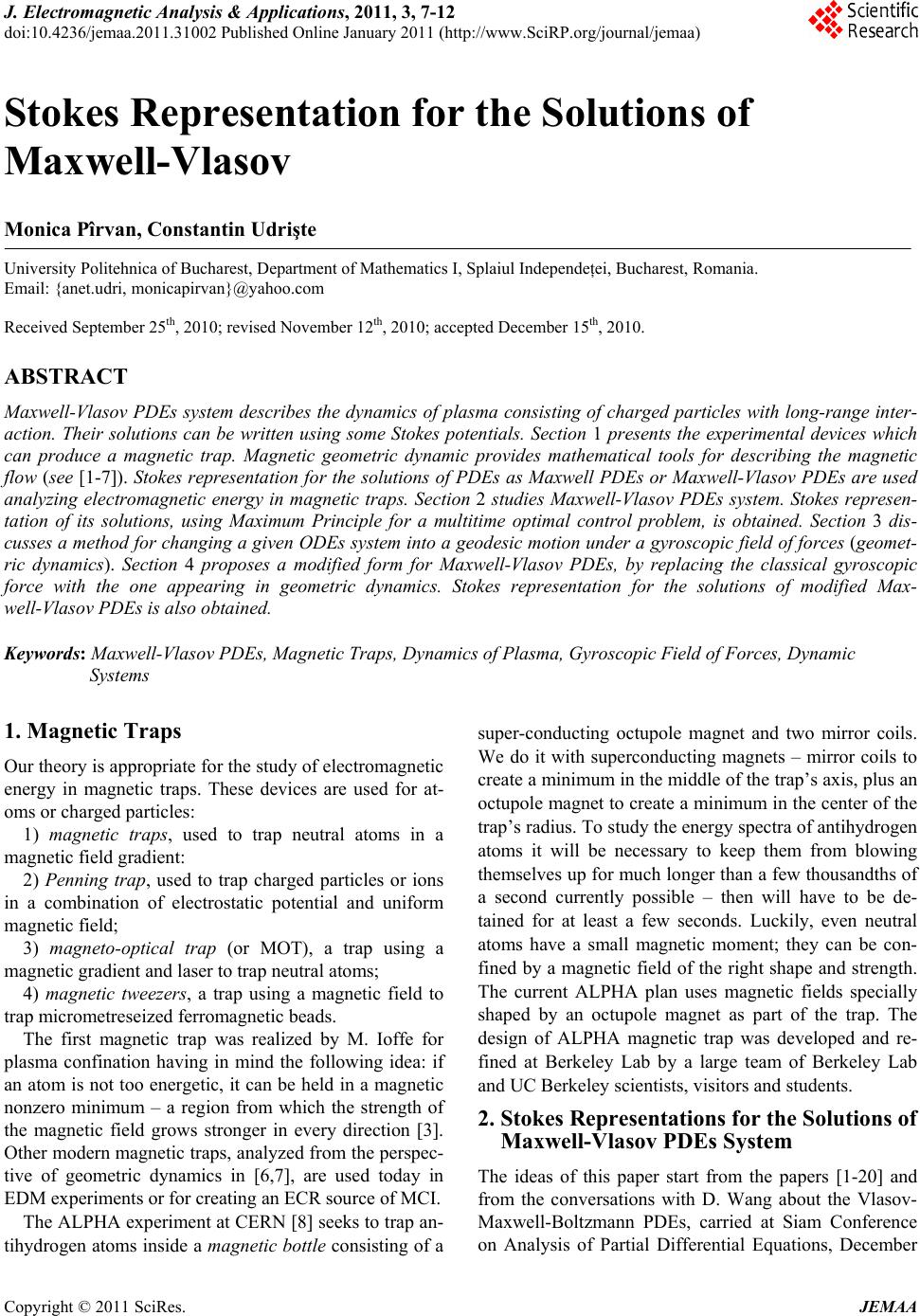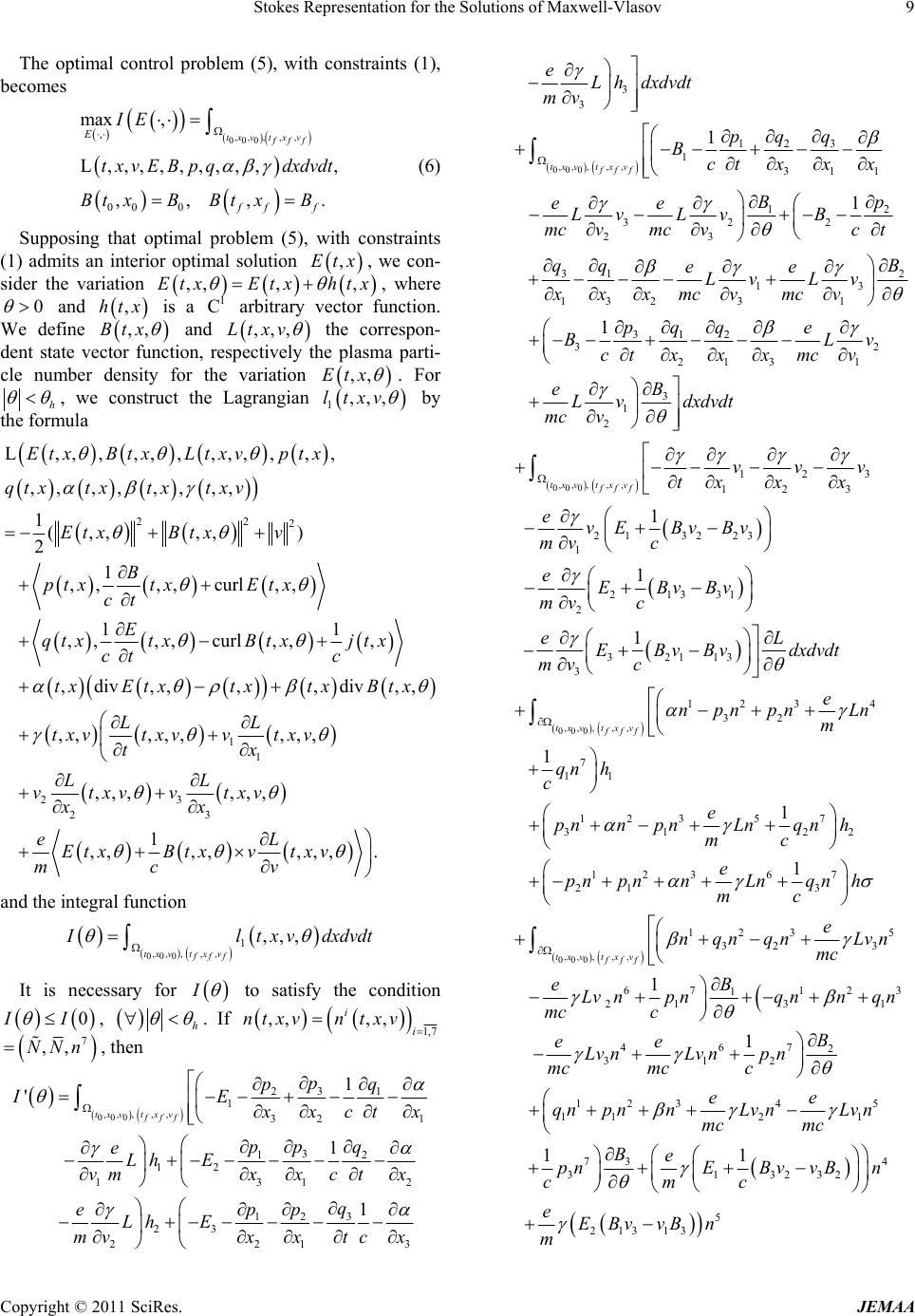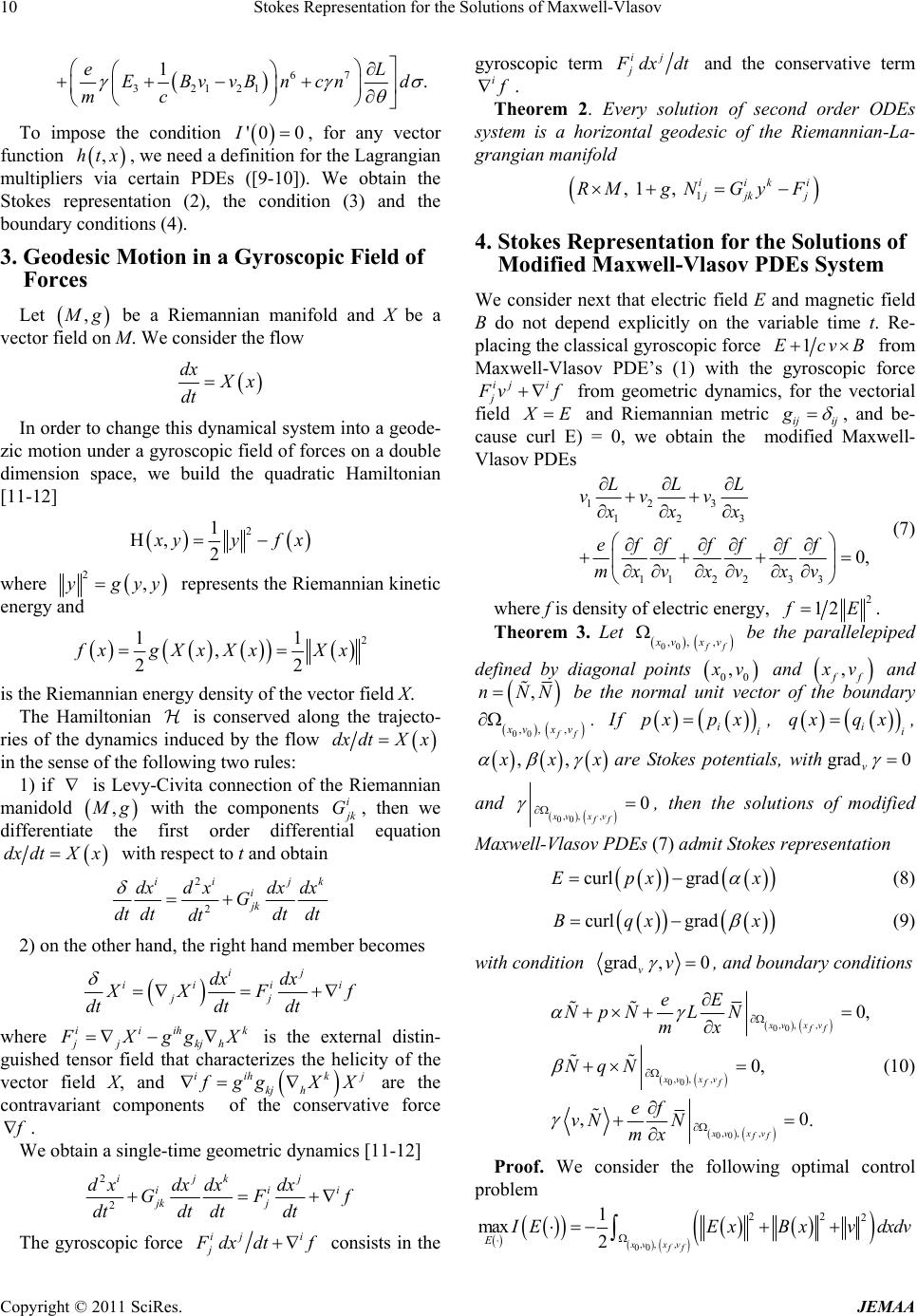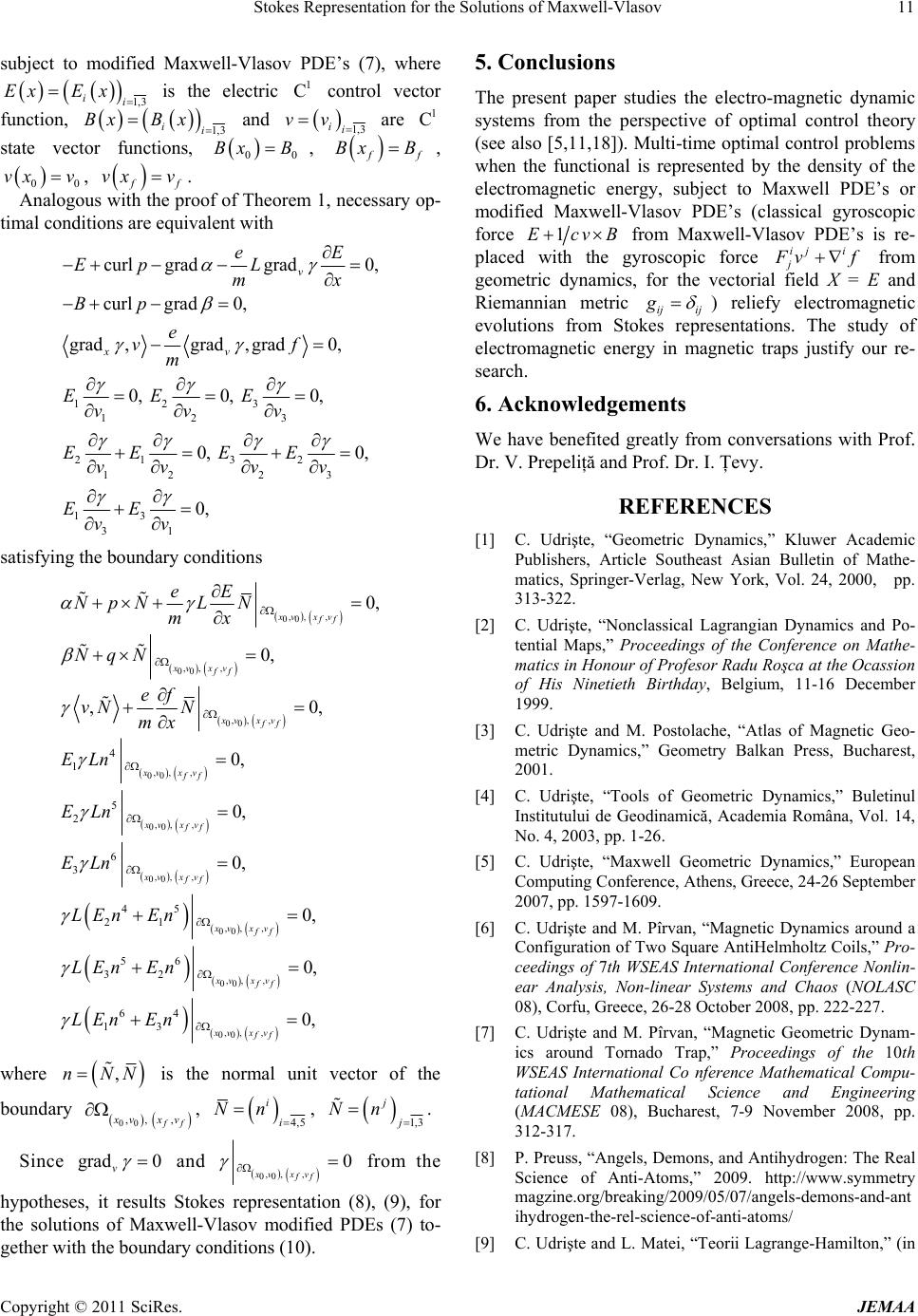 J. Electromagnetic Analysis & Applications, 2011, 3, 7-12 doi:10.4236/jemaa.2011.31002 Published Online January 2011 (http://www.SciRP.org/journal/jemaa) Copyright © 2011 SciRes. JEMAA 7 Stokes Representation for the Solutions of Maxwell-Vlasov Monica Pîrvan, Constantin Udrişte University Politehnica of Bucharest, Department of Mathematics I, Splaiul Independeţei, Bucharest, Romania. Email: {anet.udri, monicapirvan}@yahoo.com Received September 25th, 2010; revised November 12th, 2010; accepted December 15th, 2010. ABSTRACT Maxwell-Vlasov PDEs system describes the dynamics of plasma consisting of charged particles with long-range inter- action. Their solutions can be written using some Stokes potentials. Section 1 presents the experimental devices which can produce a magnetic trap. Magnetic geometric dynamic provides mathematical tools for describing the magnetic flow (see [1-7]). Stokes representation for the solutions of PDEs as Maxwell PDEs or Maxwell-Vlasov PDEs are used analyzing electromagnetic energy in magnetic traps. Section 2 studies Maxwell-Vlasov PDEs system. Stokes represen- tation of its solutions, using Maximum Principle for a multitime optimal control problem, is obtained. Section 3 dis- cusses a method for changing a given ODEs system into a geodesic motion under a gyroscopic field of forces (geomet- ric dynamics). Section 4 proposes a modified form for Maxwell-Vlasov PDEs, by replacing the classical gyroscopic force with the one appearing in geometric dynamics. Stokes representation for the solutions of modified Max- well-Vlasov PDEs is also obtained. Keywords: Maxwell-Vlasov PDEs, Magnetic Traps, Dynamics of Plasma, Gyroscopic Field of Forces, Dynamic Systems 1. Magnetic Traps Our theory is appropriate for the study of electromagnetic energy in magnetic traps. These devices are used for at- oms or charged particles: 1) magnetic traps, used to trap neutral atoms in a magnetic field gradient: 2) Penning trap, used to trap charged particles or ions in a combination of electrostatic potential and uniform magnetic field; 3) magneto-optical trap (or MOT), a trap using a magnetic gradient and laser to trap neutral atoms; 4) magnetic tweezers, a trap using a magnetic field to trap micrometreseized ferromagnetic beads. The first magnetic trap was realized by M. Ioffe for plasma confination having in mind the following idea: if an atom is not too energetic, it can be held in a magnetic nonzero minimum – a region from which the strength of the magnetic field grows stronger in every direction [3]. Other modern magnetic traps, analyzed from the perspec- tive of geometric dynamics in [6,7], are used today in EDM experiments or for creating an ECR source of MCI. The ALPHA experiment at CERN [8] seeks to trap an- tihydrogen atoms inside a magnetic bottle consisting of a super-conducting octupole magnet and two mirror coils. We do it with superconducting magnets – mirror coils to create a minimum in the middle of the trap’s axis, plus an octupole magnet to create a minimum in the center of the trap’s radius. To study the energy spectra of antihydrogen atoms it will be necessary to keep them from blowing themselves up for much longer than a few thousandths of a second currently possible – then will have to be de- tained for at least a few seconds. Luckily, even neutral atoms have a small magnetic moment; they can be con- fined by a magnetic field of the right shape and strength. The current ALPHA plan uses magnetic fields specially shaped by an octupole magnet as part of the trap. The design of ALPHA magnetic trap was developed and re- fined at Berkeley Lab by a large team of Berkeley Lab and UC Berkeley scientists, visitors and students. 2. Stokes Representations for the Solutions of Maxwell-Vlasov PDEs System The ideas of this paper start from the papers [1-20] and from the conversations with D. Wang about the Vlasov- Maxwell-Boltzmann PDEs, carried at Siam Conference on Analysis of Partial Differential Equations, December  Stokes Representation for the Solutions of Maxwell-Vlasov 8 7-10, 2009, Miami, Florida. We consider the case of collisionless plasma, i.e., the case of a single species of particles with mass m and charge e. Let 00000 0 12 ,,,,,,,, , ΩΩ Ω ffff f txvtxvtx txvv be a hyperparallelipiped in determined by the oppo- site diagonal points and 7 R v 000 ,,tx ,, ff txv . If ,Etx represents a electric field, 1 C ,Btx 1 C vx represents a magnetic field and is plasma particle number density per phase space ( 1 C ,,Ltxv being the velocity), Maxwell-Vlasov PDEs system is 1 ,, 11 curl, curl, div, div0, LLe L vEvB txmcv BE EB ctct c EρB 0, 1 j , (1) where c is the speed of light, j is the current defined by L, 2 , 0 Ω ,, f vv jtxeLtxvvdv and is the charge density, 2 , 0 Ω ,, f vv ρtxeLtxvdv, Theorem 1. Let 000 ,,,, , Ω ff txvt xv be the parallelepi- ped fixed by two diagonal points and 000 ,,txv ,, ff txv and 7 ,,,, ,,, ,,,txvN txvN txvntxv be the unit normal vector of the boundary 000 ,,,, , Ω ff txvt xv solutions of Maxwell - Vlasov PDEs (1) admit the Stokes representation . The 1 ,curl, grad, ,,grad,, 1 ,curl,grad, ,,grad,,, v v q Etx ptxαtx ct eLtxv γtxv m p Btx qtxβtx ct eLtxv γtxv v mc (2) together with the condition , 1,grad, ,0 x v γgrad γv t eEvBγtxv mc (3) and the boundary conditions 7000 7000 ,,, ,,, ,, ,,,, 1,,,Ω,,,, ,0, ,,, ,,, ,, ,,,, 1,, ,, 1,,,Ω,,,, ,0, 1 ,, , fff fff αtx N txvptxN txv eγtxv LtxvN txv m qtxntxvtx vtxv c βtx NtxvqtxN txv eγtxv LtxvN txv m γtxvLtxvv N mc ptxntxvtx vtxv c eγtxvEv BN mc c 7000 ,,,, Ω,,,, ,0, fff γtxvntxvtx vtxv (4) where ,, ,, ,, ,, ,,ptx qtx αtx βtx γtxv are Stokes potentials. Proof. We consider the following multitime optimal control problem , 000 Ω ,,,, , 22 2 1 max ,2 (,, ) fff Etxvtxv IE Et xB t xvdxdvdt , (5) constrained by Maxwell-Vlasov PDE system (1), where the electric field 1 C ,Etx is a control vector func- tion and the magnetic field and the veloc- ity v are state vector functions, 1 C ,Btx 00 0 ,,, ff Bt xBBtxB Let 1, 3 ,, ii ptxp tx , 1, 3i, ,,qtx qtx ,tx , ,tx , ,,txv be functions, consid- ered as co-state variables (Lagrange multipliers) and the Lagrange function 1 C 1 22 2 12 3 123 L,,,,,,,,, 1,, 2 1 ,,curl, 11 ,,curl,, ,div,,,div, ,, 1 ,. txvEBpq EtxBtx v B ptx Etx ct E qtxBtx jtx ct c txEtxtxtx Btx LLLL txvv vv tx xx eL EBv mc v Copyright © 2011 SciRes. JEMAA  Stokes Representation for the Solutions of Maxwell-Vlasov9 . The optimal control problem (5), with constraints (1), becomes ,, ,, , 000 , 00 0 max , L,,,,,,,,, , ,,, txvt x v fff E ff f IE txvEBp qdxdvdt Bt xBBtxB (6) Supposing that optimal problem (5), with constraints (1) admits an interior optimal solution , we con- sider the variation , where ,Etx ,htx ,, ,Etx Etx 0 and is a arbitrary vector function. We define ,htx ,,Btx 1 C and ,,,Ltxv the correspon- dent state vector function, respectively the plasma parti- cle number density for the variation ,,Etx . For h , we construct the Lagrangian , 1,,ltxv by the formula 22 2 1 L,,,,,,,,,,,, ,,,,,, ,, 1(,,,,) 2 1 ,,,,curl,, 11 ,,,,curl,,, ,div,,,,div,, ,,,,, Etx Btx Ltxvptx qtxtxtx txv EtxBtx v B ptxtxEtx ct E qtxtxBtxjtx ct c txEtxtxtx Btx L txvtxv v t 1 23 23 ,,, ,,,,,, 1 ,,,,,,,. Ltxv x LL vtxvvtxv xx eL EtxBtxv txv mc v and the integral function ,,, ,, 000 1,,, txvtx v fff ltx vdxdvdt It is necessary for I to satisfy the condition , 0II h . If 1,7 ,, ,, i i ntxvn txv 7 ,,NNn, then ,,, ,, 000 3 21 1 32 3 12 12 131 1 3 12 23 221 1 ' 1 1 txvtx v fff p pq IE 2 3 xct x p pq eLh E vmxxc tx q pp eLh E mvxxtc x ,,, ,, 000 3 3 3 12 1 311 12 322 23 31 1 132 3 1 1 txvt x v fff eL hdxdvdt mv q pq Bct xxx Bp ee Lv LvB mc vmc vct qqee LvL xxxmcv mc ,,, ,, 000 2 3 1 312 32 213 1 3 1 2 123 12 3 2132 2 1 1 1 txvt x v fff B v v pqq e BL ctxxx mcv B eL vdxdvdt mc v vvv tx xx evEBv Bv mvc v ,,, ,, 000 3 21331 2 32113 3 12 34 32 7 11 12 35 31 1 1 1 1 txvtx v fff eEBvBv mv c eL EBvB vdxdvdt mvc e npn pnLn m qn h c e pnn pnLn mc ,,, ,, 000 7 22 1236 7 21 3 123 5 32 3 67 12 1 213 1 46 312 1 1 1 txvtx v fff qn h e pnpnnLnqn h mc e nqnqn Lvn mc B eLvnpnqnnq n mc c ee LvnLv npn mcmc c 3 72 1234 5 112 1 74 3 313232 5 213 13 11 B ee qn pnnLvnLvn mc mc Be pnEBv vBn cmc eEBv vB n m Copyright © 2011 SciRes. JEMAA  Stokes Representation for the Solutions of Maxwell-Vlasov 10 67 32121 1 . eL EBvvBncnd mc To impose the condition , for any vector function , we need a definition for the Lagrangian multipliers via certain PDEs ([9-10]). We obtain the Stokes representation (2), the condition (3) and the boundary conditions (4). '0 0I ,htx 3. Geodesic Motion in a Gyroscopic Field of Forces Let , g be a Riemannian manifold and X be a vector field on M. We consider the flow dx x dt In order to change this dynamical system into a geode- zic motion under a gyroscopic field of forces on a double dimension space, we build the quadratic Hamiltonian [11-12] 2 1 H, 2 yyfx where 2,ygyy represents the Riemannian kinetic energy and 2 11 , 22 xgXx XxXx is the Riemannian energy density of the vector field X. The Hamiltonian is conserved along the trajecto- ries of the dynamics induced by the flow dx dtXx in the sense of the following two rules: 1) if is Levy-Civita connection of the Riemannian manidold , g with the components i k G, then we differentiate the first order differential equation xdxdt X with respect to t and obtain 2 2 ii jk i jk dxd xdxdx G dt dtdtdt dt 2) on the other hand, the right hand member becomes ij ii i jj dxdx i XF dtdt dt f k where iiih jj kjh Xgg X ii is the external distin- guished tensor field that characterizes the helicity of the vector field X, and h k kj h j ggXX are the contravariant components of the conservative force . We obtain a single-time geometric dynamics [11-12] 2 2 ijkj ii jk j d xdxdxdx GF dt dtdt dt i f The gyroscopic force iji j dx dtf consists in the gyroscopic term ij j dxdt and the conservative term i . Theorem 2. Every solution of second order ODEs system is a horizontal geodesic of the Riemannian-La- grangian manifold 1 , 1, iiki jk j RMgNGy F 4. Stokes Representation for the Solutions of Modified Maxwell-Vlasov PDEs System We consider next that electric field E and magnetic field B do not depend explicitly on the variable time t. Re- placing the classical gyroscopic force 1EcvB from Maxwell-Vlasov PDE’s (1) with the gyroscopic force ij j i vf from geometric dynamics, for the vectorial field E and Riemannian metric ij ij g , and be- cause curl E) = 0, we obtain the modified Maxwell- Vlasov PDEs 12 3 123 112 23 3 0, LLL vv v xxx effffff mxv xvxv (7) where f is density of electric energy, 2 12 E. Theorem 3. Let 00 ,, , f vxv be the parallelepiped defined by diagonal points 00 , v and , f v and ,N nN be the normal unit vector of the boundary 00 ,, , f vxv . If p x ii px, ii xqx q, ,, xx are Stokes potentials, with grad 0 v and ,, , 00 0 xvx v ff , then the solutions of modified Maxwell-Vlasov PDEs (7) admit Stokes representation curl gradEpx x (8) curl gradBqx x (9) with condition grad ,0 vv , and boundary conditions ,, , 00 ,, , 00 ,, , 00 0, 0, ,0 xvx v ff xvx v ff xvx v ff eE NpNLN mx NqN ef vN N mx . (10) Proof. We consider the following optimal control problem ,, , 00 22 2 1 2xvx v ff max EEExB xvdxdv Copyright © 2011 SciRes. JEMAA  Stokes Representation for the Solutions of Maxwell-Vlasov11 subject to modified Maxwell-Vlasov PDE’s (7), where 1,3 ii ExEx is the electric control vector function, 1 C 1,3 ii BxB x and 1,3 ii vv are state vector functions, 1 C Bx 00 B, f BBx , , 00 vx v f vx v. Analogous with the proof of Theorem 1, necessary op- timal conditions are equivalent with 12 3 123 213 2 122 3 13 31 curl gradgrad0, curl grad0, grad,grad ,grad0, 0, 0, 0, 0, 0, 0, v xv eE EpL mx Bp e vf m EE E vvv EE EE vvvv EE vv satisfying the boundary conditions ,, , 00 ,, , 00 ,, , 00 ,, , 00 ,, , 00 ,, , 00 ,, , 00 4 1 5 2 6 3 45 21 56 32 0, 0, , 0, 0, 0, 0, xvx v ff xvx v ff xvx v ff xvx v ff xvx v ff xvx v ff xvx v ff eE NpNLN mx NqN ef vN N mx ELn ELn ELn LEn En LEn En 0 , ,, , 00 ,, , 00 64 13 0, 0, xvx v ff xvx v ff LEnEn where ,nNN is the normal unit vector of the boundary 00 ,, , f vxv , 4,5 i i Nn , 1,3 j j Nn . Since grad 0 v and ,, , 00 0 xvx v ff from the hypotheses, it results Stokes representation (8), (9), for the solutions of Maxwell-Vlasov modified PDEs (7) to- gether with the boundary conditions (10). 5. Conclusions The present paper studies the electro-magnetic dynamic systems from the perspective of optimal control theory (see also [5,11,18]). Multi-time optimal control problems when the functional is represented by the density of the electromagnetic energy, subject to Maxwell PDE’s or modified Maxwell-Vlasov PDE’s (classical gyroscopic force 1EcvB from Maxwell-Vlasov PDE’s is re- placed with the gyroscopic force ij i j vf from geometric dynamics, for the vectorial field X = E and Riemannian metric ij ij g ) reliefy electromagnetic evolutions from Stokes representations. The study of electromagnetic energy in magnetic traps justify our re- search. 6. Acknowledgements We have benefited greatly from conversations with Prof. Dr. V. Prepeliţă and Prof. Dr. I. Ţevy. REFERENCES [1] C. Udrişte, “Geometric Dynamics,” Kluwer Academic Publishers, Article Southeast Asian Bulletin of Mathe- matics, Springer-Verlag, New York, Vol. 24, 2000, pp. 313-322. [2] C. Udrişte, “Nonclassical Lagrangian Dynamics and Po- tential Maps,” Proceedings of the Conference on Mathe- matics in Honour of Profesor Radu Roşca at the Ocassion of His Ninetieth Birthday, Belgium, 11-16 December 1999. [3] C. Udrişte and M. Postolache, “Atlas of Magnetic Geo- metric Dynamics,” Geometry Balkan Press, Bucharest, 2001. [4] C. Udrişte, “Tools of Geometric Dynamics,” Buletinul Institutului de Geodinamică, Academia Româna, Vol. 14, No. 4, 2003, pp. 1-26. [5] C. Udrişte, “Maxwell Geometric Dynamics,” European Computing Conference, Athens, Greece, 24-26 September 2007, pp. 1597-1609. [6] C. Udrişte and M. Pîrvan, “Magnetic Dynamics around a Configuration of Two Square AntiHelmholtz Coils,” Pro- ceedings of 7th WSEAS International Conference Nonlin- ear Analysis, Non-linear Systems and Chaos (NOLASC 08), Corfu, Greece, 26-28 October 2008, pp. 222-227. [7] C. Udrişte and M. Pîrvan, “Magnetic Geometric Dynam- ics around Tornado Trap,” Proceedings of the 10th WSEAS International Co nference Mathematical Compu- tational Mathematical Science and Engineering (MACMESE 08), Bucharest, 7-9 November 2008, pp. 312-317. [8] P. Preuss, “Angels, Demons, and Antihydrogen: The Real Science of Anti-Atoms,” 2009. http://www.symmetry magzine.org/breaking/2009/05/07/angels-demons-and-ant ihydrogen-the-rel-science-of-anti-atoms/ [9] C. Udrişte and L. Matei, “Teorii Lagrange-Hamilton,” (in Copyright © 2011 SciRes. JEMAA  Stokes Representation for the Solutions of Maxwell-Vlasov Copyright © 2011 SciRes. JEMAA 12 Romanian) Monographs and Textbooks 8, Geometry Balkan Press, Bucharest, 2008. [10] C. Udrişte, “Simplified Multitime Maximum Principle,” Balkan Journal of Geometry and Its Applications, Vol. 14, No. 1, 2009, pp. 102-119. [11] C. Udrişte, M. Ferrara and D. Opriş, “Economic Geomet- ric Dynamics,” Monographs and Textbooks 6, Geometry Balkan Press, Bucharest, 2004. [12] C. Udrişte, “Geodesic Motion in a Gyroscopic Field of Forces,” Tensor, N. S., Vol. 66, No. 3, 2005, pp. 215-228. [13] H. Cendra, D. D. Holm, M. J. W. Hoyle and J. E. Mars- den, “The Maxwell-Vlasov Equations in Euler-Poincaré form,” Journal of Mathematical Physics, Vol. 39, No. 6, 1998, pp. 3138-3157. doi:10.1063/1.532244 [14] V. Ciancio and C. Udrişte, “Ioffe-Ştefănescu Magnetic Trap,” Revue Roumaine de Sciences Techniques-Serie Electrotechnique et Energetique, Vol. 49, No. 2, 2004, pp. 157-176. [15] Y. Guo, “Global Weak Solutions of the Vlasov-Maxwell System with Boundary Conditions,” Communications in Mathematical Physics, Vol. 154, No. 2, 1993, pp. 245- 263. doi:10.1007/BF02096997 [16] E. Marsden and T. S. Raţiu, “Intro-Duction to Mechanics and Symmetry,” 2nd Edition, Springer, New York, 1999. [17] C. Neagu and C. Udrişte, “From PDE Systems and Met- rics to Geometric Multi-time Field Theories,” Seminarul de Mecanică, Sisteme Dinamice Diferenţiale, 79, Univer- sitatea de Vest din Timişoara, 2001. [18] M. Pîrvan and C. Udrişte, “Optimal Control of Electro- magnetic Energy,” Balkan Journal of Geometry and Its Applications, Vol. 15, No. 1, 2010, pp. 131-141. [19] C. Udrişte, “Nonholonomic Aapproach of Multitime Maximum Principle,” Balkan Journal of Geometry and Its Applications, Vol. 14, No. 2, 2009, pp. 101-116. [20] D. Wang and X. Hu, “Weak Stability and Hydrodynamic Limit of Vlasov-Maxwell-Bolzmann Equations,” SIAM Conference on Analysis of Partial Differential Equations, Miami, Florida, 7-10 December 2009, p. 78.
|